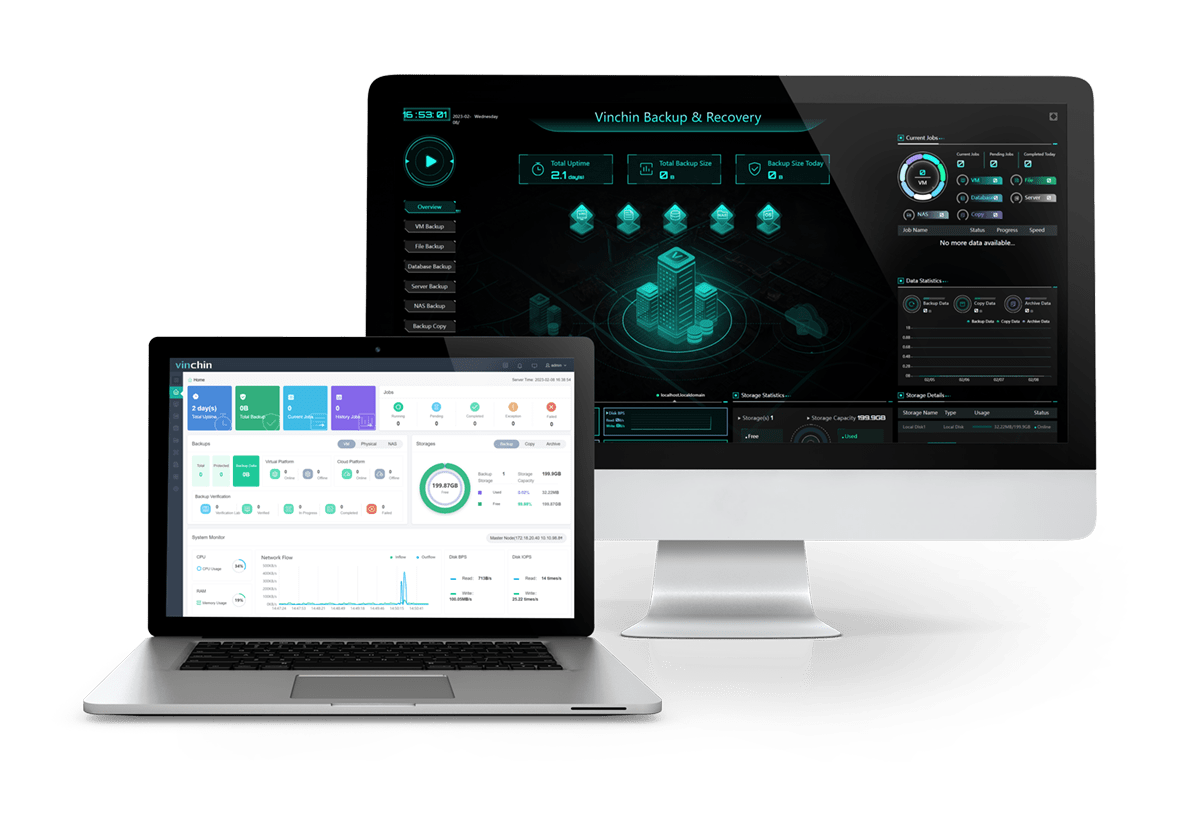-
What is Disaster Recovery (DR)?
-
What is a Disaster Recovery Plan?
-
Why is a Disaster Recovery Plan Important?
-
Recovery Point Objective (RPO) And Recovery Time Objective (RTO)
-
Disaster Tolerance VS Fault Tolerance VS Disaster Recovery
-
Disaster Recovery and Backup have Different Purposes
-
Backup is the Cornerstone
-
Disaster Recovery is Essential
-
Disaster Recovery cannot Replace Backup
-
What are the Differences between Business Continuity and Disaster Recovery?
-
How Should Enterprises Build Their Own Disaster Recovery Plan?
-
Commonly Used Disaster Recovery Combination Methods
-
Choosing a Disaster Recovery Solution
-
Conclusion
Data backup and disaster recovery have always been a concern for enterprises, and enterprises have taken great pains to preserve critical data. Data backup and disaster recovery of critical data are crucial for every business. Loss of critical data means the demise of the enterprise.
For enterprises, once the data is damaged due to some irresistible natural force or human factors, it will not only bring great difficulties to the operation of the enterprise, but also seriously affect the credibility of the enterprise, putting it at a disadvantage in the competition and giving rise to The company has caused immeasurable losses. Data information is the most valuable wealth of an enterprise. Therefore, disaster recovery is essential.
What is Disaster Recovery (DR)?
Disaster recovery refers to the process of reactivating the data, hardware and software equipment of the information system and restoring normal business operations after a natural or man-made disaster.
What is a Disaster Recovery Plan?
A disaster recovery plan is a document that covers how an organization can resume work after a disaster strikes. This plan is used in all aspects of the organization that rely on informational technology (IT).
A disaster recovery plan (DRP) specifies what exactly the organization needs to do in order to minimize the effects of the disaster--so that it can continue its mission-critical operations.
Before creating a DRP, an organization first analyzes the business processes and continuity needs. Then, it performs a risk analysis (RA) and a business impact analysis (BIA) and sets recovery objectives.
Why is a Disaster Recovery Plan Important?
Disaster recovery is critical because it allows companies to:
Anticipate and prevent avoidable events.
Respond to and recover from inevitable events.
When a disaster strikes, a recovery plan can reduce losses and help teams respond appropriately to the problem. Therefore, disaster recovery can provide the following benefits during and after an emergency:
Limit the impact of unforeseen incidents.
Keep services and operations active in times of crisis.
Minimize revenue losses.
Enable smooth and quick system restoration.
Help the team stay calm when disaster strikes.
Some businesses require disaster recovery plans to meet compliance regulations. Companies operating in the financial, healthcare and government sectors are often legally obliged to prepare for some form of DR.
Recovery Point Objective (RPO) And Recovery Time Objective (RTO)
A Recovery Point Objective (RPO) is the maximum acceptable interval during which transactional data is lost from an IT service.
For example, if RPO is measured in minutes, then in practice, off-site mirrored backups must be continuously maintained as a daily off-site backup will not suffice.
The Recovery Time Objective (RTO) is the targeted duration of time and a service level within which a business process must be restored after a disruption in order to avoid a break in business continuity.
According to business continuity planning methodology, the RTO is established during the Business Impact Analysis (BIA) by the owner(s) of the process, including identifying time frames for alternate or manual workarounds.
Disaster Tolerance VS Fault Tolerance VS Disaster Recovery
Disaster tolerance: refers to keeping the business of the production system running uninterrupted while ensuring that the data of the production system is lost as little as possible when a disaster occurs.
Fault tolerance: refers to the ability to ensure that the computer system can still work when the software and hardware of the computer system fail.
Fault tolerance can be achieved through hardware redundancy, error checking and hot swapping and some special software, while disaster recovery must be achieved through technologies such as system redundancy, disaster detection and system migration. When equipment failure cannot be resolved through the fault tolerance mechanism and causes system downtime, the resolution of this failure falls into the category of disaster recovery.
Disaster recovery: refers to the ability to restore a system to normal operation after a disaster has occurred.
Disaster tolerance emphasizes the ability to ensure uninterrupted operation of system during a disaster while disaster recovery focuses on recovering systems after a disaster has occurred.
Disaster Recovery and Backup have Different Purposes
The purpose of the disaster recovery is to ensure the "onlineness" of system data and services, that is, when the system fails, it can still provide data and services to the network system normally so that the system does not stop.
Backup is "the process of transferring online data to offline data", and its purpose is to deal with logical errors in system data and preserve historical data.
Therefore, today, when various fault-tolerant technologies are abundant, backup systems are still irreplaceable.
Backup is the Cornerstone
Backup refers to the process of copying the entire system or part of the data set from the hard disk or array of the application host to other storage media in order to prevent data loss due to system operation errors or system failures.
Backup is the last line of defense for high data availability, and its purpose is to restore data when system data crashes.
Disaster Recovery is Essential
So if a backup system is built, is there no need for a disaster recovery system? This also depends on the expectations of the business department for the RTO / RPO indicators. If a 1TB database is allowed to have RTO = 8 hours and RPO = 1 day, then the backup system can fulfil requirements. At the same time, the purpose of backup is to deal with logical errors in system data and preserve historical data. It can only meet the purpose of data recovery when data is lost or damaged, but cannot provide real-time business takeover function.
Therefore, disaster recovery is also essential for some critical businesses. It means that when the production system fails to work normally, its business can be taken over by the disaster recovery system and normal work can continue.
Disaster recovery can provide good RTO and RPO indicators. At the same time, the remote disaster recovery system has the ability to cope with various disasters, especially regional and devastating disasters, and has relatively complete data protection and disaster recovery functions to ensure the integrity of data and business continuity when a disaster strikes, and ensure that the system can be restored in the shortest possible time to minimize losses.
Disaster Recovery cannot Replace Backup
The disaster recovery system will completely copy any changes in the production system to the disaster recovery end, including work that you do not want it to be copied. For example, if the user information table in the billing system is accidentally deleted, that on the disaster recovery side will also be completely deleted. At this time, you need to take out the latest backup from the backup system to restore the mistakenly deleted information. Therefore, the disaster recovery system cannot replace the backup system.
What are the Differences between Business Continuity and Disaster Recovery?
People often get confused between a disaster recovery plan and a business continuity plan. Yes, a disaster recovery plan is a crucial part of a business continuity plan, but the two plans are not the same.
Although business continuity and disaster recovery planning are intertwined, they have different focuses. The former focuses on the business as a whole, while the latter focuses more on information systems. Business continuity planning involves several specific plans, including a disaster recovery plan. The two plans differ in scope, but disaster recovery planning is considered a subset of business continuity planning. Without a tactical action plan to immediately handle an information system outage, business continutity plan is doomed to fail.
How Should Enterprises Build Their Own Disaster Recovery Plan?
How an enterprise establishes a disaster recovery plan mainly depends on the needs of the business:
Types of disasters that need to be prevented
Allowed RTO and RPO indicators
System investment
Here is a disaster recovery plan checklist to help you perfect your plan.
Commonly Used Disaster Recovery Combination Methods
Based on the above reasons, the industry generally follows the following methods in building disaster recovery systems:
1. Build a local backup system in the datacenter
2. Build an off-site backup system
This method can meet the backup and off-site disaster recovery functions at the same price as the backup system, and can avoid data loss in the main production center due to earthquakes, fires or other disasters.
3. Backup system + off-site disaster recovery system
This is an ideal integrated disaster recovery system solution that can avoid various possible errors to a large extent.
Choosing a Disaster Recovery Solution
As a professional data protection solution provider, Vinchin owns the leading disaster recovery technology to all kinds of data security problems and provides reliable disaster recovery solutions to every client in many industries.

Vinchin Backup & Recovery is a professional solution which supports data backup of VM like VMware vSphere, Hyper-V, XenServer, XCP-ng, oVirt, RHV, OpenStack, etc. and other data like database, NAS, file server, etc.
By using Vinchin Backup & Recovery, you can instantly recover the entire VM and all its data from any restore point (no matter it's a full backup, incremental backup or differential backup) without any effectings on the original backup data. Any deduplicated or compressed backups can be recovered. It is an excellent solution to ensure business continuity, minimize the loss of crucial business interruption caused by disaster or system failure.
Vinchin Backup & Recovery is also helpful for disaster recovery because Instant Recovery and Cross-Platform Migration will help you recover failed VM from its backup in 15 seconds and move VM between different hypervisors as you wish (Hyper-V is not supported for now).
Vinchin Backup & Recovery has been selected by thousands of companies and organizations for disaster recovery and you can also start to use this powerful system with a 60-day full-featured free trial. Just click the button to get the installation package.
Conclusion
Disaster recovery involves restoring data, hardware, and software systems after a natural or man-made disaster to resume normal business operations. A well-designed disaster recovery plan is essential for minimizing the impact of disasters, maintaining business continuity, and safeguarding critical data.
Share on:








